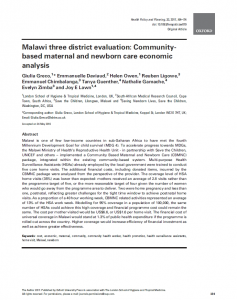
Malawi is one of few low-income countries in sub-Saharan Africa to have met the fourth Millennium Development Goal for child survival (MDG 4). To accelerate progress towards MDGs, the Malawi Ministry of Health’s Reproductive Health Unit – in partnership with Save the Children, UNICEF and others – implemented a Community Based Maternal and Newborn Care (CBMNC) package, integrated within the existing community-based system. Multi-purpose Health Surveillance Assistants (HSAs) already employed by the local government were trained to conduct five core home visits. The additional financial costs, including donated items, incurred by the CBMNC package were analysed from the perspective of the provider. The coverage level of HSA home visits (35%) was lower than expected: mothers received an average of 2.8 visits rather than the programme target of five, or the more reasonable target of four given the number of women who would go away from the programme area to deliver. Two were home pregnancy and less than one, postnatal, reflecting greater challenges for the tight time window to achieve postnatal home visits. As a proportion of a 40 hour working week, CBMNC related activities represented an average of 13% of the HSA work week. Modelling for 95% coverage in a population of 100,000, the same number of HSAs could achieve this high coverage and financial programme cost could remain the same. The cost per mother visited would be US$6.6, or US$1.6 per home visit. The financial cost of universal coverage in Malawi would stand at 1.3% of public health expenditure if the programme is rolled out across the country. Higher coverage would increase efficiency of financial investment as well as achieve greater effectiveness.
*This article is part of a series of eight papers that includes the first multi-country, economic and systems analyses of community based maternal-newborn care. Access the series here >>